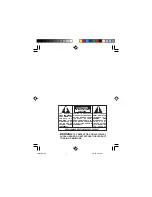
D100-67-00
1
I56-1148-04
DH100 Air Duct Smoke Detector
INSTALLATION AND MAINTENANCE INSTRUCTIONS
A Division of Pittway
3825 Ohio Avenue, St. Charles, Illinois 60174
1-800-SENSOR2, FAX: 630-377-6495
Before Installing
Please thoroughly read the System Sensor
Guide for Proper
Use of Smoke Detectors in Duct Applications
(I56-473)
,
which provides detailed information on detector spacing,
placement, zoning, wiring, and special applications. Cop-
ies of this manual are available from System Sensor. NFPA
Standards 72 and 90A should also be referenced for de-
tailed information.
NOTICE:
This manual should be left with the owner/user
of this equipment.
IMPORTANT:
This detector must be tested and maintained
regularly following NFPA 72 requirements. The detector
should be cleaned at least once a year.
Table of Contents
Page
[1] General Description
1
[2] Limitations of Duct Smoke Detectors
1
[3] Exploded View of Duct Smoke Detector Components 2
[4] Contents of the Duct Smoke Detector Kit
2
[5] Installation Sequence
2
[6] Duct Smoke Detector Maintenance and Test Procedures 5
[7] Detector Cleaning Procedures
7
[8] Board Replacement
7
[9] Specifications
8
Warranty
8
[1] General Description
An HVAC system supplies conditioned air to virtually every
area of a building. Smoke introduced into this air duct sys-
tem will be distributed to the entire building. Smoke detec-
tors designed for use in air duct systems are used to sense
the presence of smoke in the duct.
Model DH100 Air Duct Smoke Detectors are supplied as a
photoelectronic model. This smoke detection method is
combined with an efficient housing design that samples air
passing through a duct and allows detection of a develop-
ing hazardous condition. When sufficient smoke is sensed,
an alarm signal is initiated at the fire control panel monitor-
ing the detector, and appropriate action can be taken to
shut off fans, blowers, change over air handling systems,
etc. These actions can facilitate the management of toxic
smoke and fire gases throughout the areas served by the
duct system.
DH100 detectors are designed to operate with 12 or 24
VDC UL listed compatible 2-wire control panels. Alarm
current must be limited to 100mA or less by the control
panel. Auxiliary relay contacts for control purposes are
not available for use with the DH100. Control must ini-
tiate from the control panel.
For testing, the alarm can be enabled by a magnet acti-
vated test switch or by the optional remote test station.
The duct smoke detector latches into alarm state when
an alarm occurs. A green LED flashes to indicate power,
a red LED signals local alarm indication, and optional
accessories offer a variety of annunciation capabilities.
The DH100 can be reset by a momentary power interrup-
tion, the reset button on the front cover, the control panel,
or remote reset accessory.
[2] Limitations Of Duct Smoke Detectors
WARNING
The National Fire Protection Association has established
that DUCT DETECTORS MUST NOT BE USED AS A SUB-
STITUTE FOR OPEN AREA DETECTOR PROTECTION as a
means of providing life safety. Nor are they a substitute for
early warning in a building’s regular fire detection system.
System Sensor supports this position and strongly recom-
mends that the user read NFPA Standards 90A, 72, and 101.
The DH100 Air Duct Smoke Detectors are listed per UL 268A.
WARNING
This device will not operate without electrical power.
Fire situations may cause an interruption of power. The
system safeguards should be discussed with your local fire
protection specialist.
WARNING
This device will not sense smoke unless the ventilation sys-
tem is operating and the cover is installed.
WARNING
For this detector to function properly, it MUST be installed
according to the instructions in this manual. Furthermore,
the detector MUST be protected from the elements and op-
erated within ALL electrical and environmental specifica-
tions listed in this manual. Failure to comply with these
requirements may prevent the detector from activating
when smoke is present in the air duct.


























